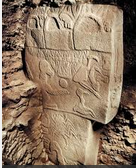 Gobekli Tepe is probably 11,500 years old. People living at that time were supposed (according to a prevailing archeological opinion) to have been hunter-gatherers who never settled in one spot for long and who certainly never erected buildings, monuments, or permanent temples.
Gobekli Tepe is probably 11,500 years old. People living at that time were supposed (according to a prevailing archeological opinion) to have been hunter-gatherers who never settled in one spot for long and who certainly never erected buildings, monuments, or permanent temples.
Göbekli Tepe is now considered to comprise the world's oldest known religious structures. Located on a hilltop, the site contains 20 round structures surrounded by large T-shaped, limestone pillars Slabs used for the pillars were sourced from bedrock pits about 100 meters away, Many of the pillars are decorated with carved reliefs of animals and other pictograms.
Somewhere around 8000 BCE someone buried the entire site in dirt and left it abandoned. So, not only does Gobekli Tepe represent a scope of building project that wasn't supposed to be happening at its time period, but it also represents an attempt at preservation, concealment, or perhaps repudiation that, to put it mildly, is difficult to explain.
Gobekli Tepe raises more questions than answers. Unfortunately, so does this article by Paul D. Burley, who has been studying the pictograms.
"What is important here is for some unknown reason the builders of Gobekli Tepe constructed a temple apparently highlighting a time 11,600 years in their future."
It seems that he intended to make a case based on his interpretation of the images he claims depict the location of the ecliptic intersecting the galactic plane. Maybe that location is correct only during our time, and not at the time the pictograms were made. But for those of us not thoroughly schooled in archeoastronomy this conclusion is much less than obvious.
Gobekli Tepe - Temples Communicating Ancient Cosmic Geography